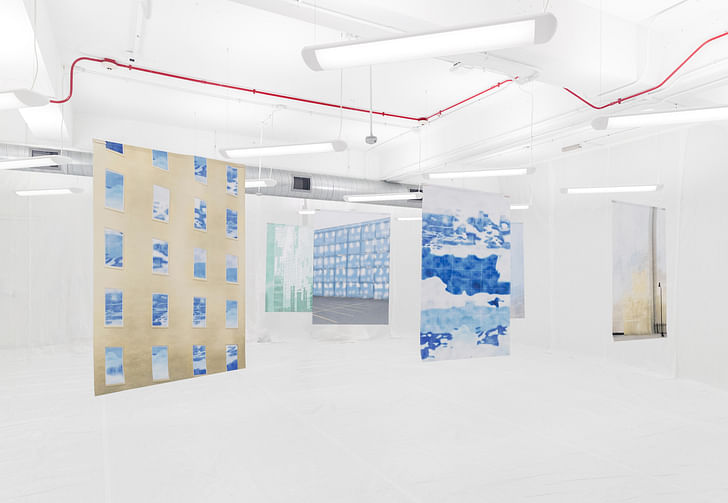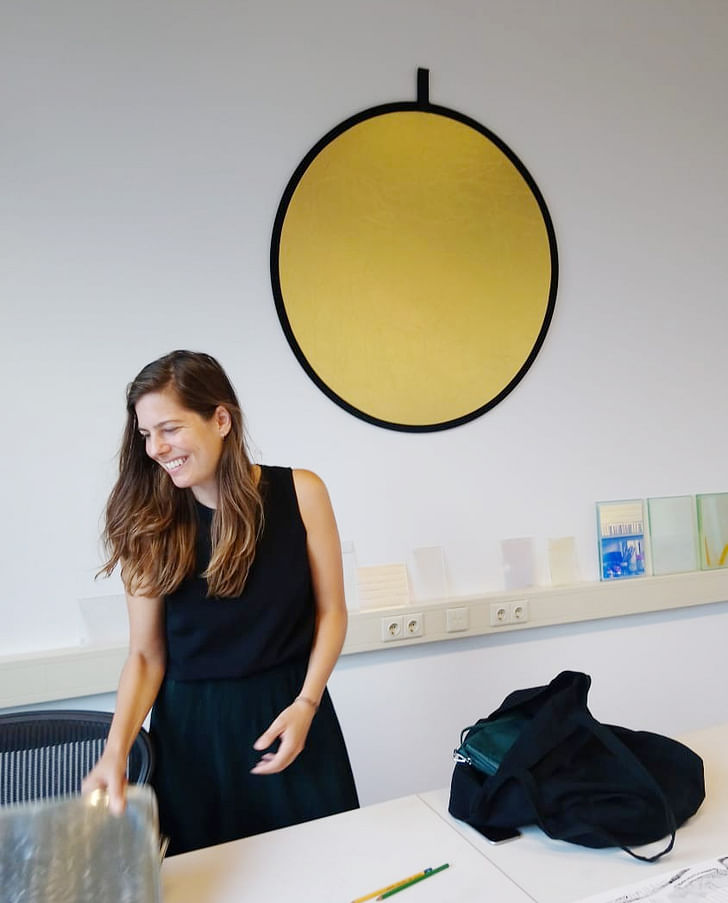

Fellow Fellows is a series that focuses on the increasingly important role fellowships play in architecture academia today. These prestigious academic positions can bring forth a fantastic blend of practice, research, and pedagogical cross-pollination, often within a tight time frame. They also, by definition, represent temporary, open-ended, and ultimately precarious employment for aspiring young designers and academics. Fellow Fellows aims to understand what these positions offer for both the fellows themselves and the discipline at large by presenting their work and experiences through an in-depth interview. Fellow Fellows is about bringing attention and inquiry to the otherwise maddening pace of academia, while also presenting a broad view of the exceptional and breakthrough work being done by people navigating the early parts of their careers.
This week we talk to Anne Dessing, the 2018-2019 Douglas A. Garofalo Fellow at the University Illinois Chicago.
What fellowship were you in and what brought you to that fellowship?
I was the Douglas A. Garofalo Fellow ’18-’19 at the University Illinois Chicago. The Fellowship was brought to my attention through Fosco Lucarelli of SOCKS studio. He was the Fellow a year before me and he suggested the position would be a good fit for me, as well. I never thought of participating in a Fellowship before, I hardly knew they existed, but after the invite I understood this as a great chance to do research. On top of that I was very excited about the idea of living in Chicago for a year.
What was the focus of the fellowship research?
I wrote my research proposal based on a quote by Bruno Latour:
“Walls are a nice invention, but if there were no holes in them, there would be no way to get in or out; they would be mausoleums or tombs. The problem is that, if you make holes in the walls, anything and anyone can get in and out (bears, visitors, dust, rats, noise). So architects invented this hybrid: a hole-wall, often called a door, which, although common enough, has always struck me as a miracle of technology.”
During my Fellowship, I investigated open borders, including architectural borders that aren't closed off by solid walls. I was interested in how segregation and inequality relate to physical architectural borders in contemporary American cities.
Today politics in America sets hard borders, including architectural walls, while in other fields there is a tendency to look at borders in a more nuanced way.
These developments made me want to better understand what a boundary means in the physical and static world of architecture...
Today, politics in America sets hard borders, including architectural walls, while in other fields there is a tendency to look at borders in a more nuanced way. The interdependence of societies has increased enormously in recent decades: Borders fade under the influence of globalization, digitization, and climate change. Every day, billions of interactions take place all over the world, with goods, capital and people becoming more mobile. Communication and energy networks are intertwined so that news, data and energy can move at the speed of light. These developments made me want to better understand what a boundary means in the physical and static world of architecture today and I wanted to experiment with distorting these borders so that they can be interpreted and used in different ways.
What did you produce and teach?
The research was conducted by teaching a studio about this subject and through my individual trajectory. In addition to the research program, I taught a seminar focused on architectural representation. At the end of my Fellowship, I made an exhibition and gave a lecture at the Graham Foundation.
For the studio, Open Borders, the students made an atlas of situations we found in the city of Chicago. We photographed the streets and then analyzed their borders. We made drawings in order to understand the spatial consequences of these borders, everything from lines on roads to unfolded sun-blinds, glass facades, and closed doors.
During the second part of the assignment, the students designed a new threshold that replaced an existing solid border in the city, with this threshold preferably located on a public building or an infrastructural element dividing two neighborhoods. The designs transformed the relationships between these separated worlds. Because we used our atlas, filled with examples of situations found in the city, we were able to work with a language and quality that was inherited directly from the city of Chicago itself.
My individual research was based on my travels in the Midwest. In my time outside the university I visited many other cities around Chicago. My partner happened to be in the States for the exact same period. He was a Loeb Fellow at Harvard GSD. We decided not to meet only in Boston or Chicago, but to exploit the situation and meet at places in between. So, during my Fellowship I have been to St. Louis, Detroit, Madison, Taliesin, Pittsburgh, Washington DC., New York, and Syracuse. These trips were very inspiring and they provided a framework and better understanding of American culture and the role Chicago has in it today. I documented those trips through photos and I felt a strong need to bundle, analyze and select the image material with a focus on my research topic.
Can you talk about what was exhibited?
The work culminated in a series of big drawings, presented in the exhibition “And then when I went to Chicago, that’s when I had these outer space experiences and went to the other planets.” The title is a quote by Afrofuturism pioneer Sun Ra, whom I revere for showing how art and imagination can help people look beyond this world and into another.
I cultivated an outsider’s view of cities in the American Midwest, recasting their surfaces as fluid border conditions that continually dissolve and reassemble. The work directs careful attention to the ambiguous visual character of these places, defined through conflicting impressions of surface and depth, substance and shine, aspiration and ordinariness.
I captured unexpected hyperreal settings—environments where reality and representation are indistinguishable. The reflective, mirrored surfaces in the drawings play with light, multiplying into the space around them. At the same time, shininess renders such surfaces—and what is behind them—illegible. This quality lures but also obscures, concealing plainness more often than beauty or mystery.
I cultivated an outsider’s view of cities in the American midwest [...] The work directs careful attention to the ambiguous visual character of these places, defined through conflicting impressions of surface and depth, substance and shine, aspiration and ordinariness.
Today, cities are made up of these types of flat, shiny surfaces: screens and facades of all scales. We continuously encounter various shallow worlds that dictate our psychic experiences and cultural conventions. This is even more apparent in the sprawling Midwest, where the extensive, emblematic grid and towering skyscrapers wrapped in gleaming windows stand in stark contrast, and everyday interiors—places like bars and waiting rooms—can be subtly dominated by lifeless screens, as if offering a backdrop of the outside world. Whether the glossy pages of a magazine, the filters that infuse our virtual feed, or the buildings that tower over us, our culture is infatuated with seizing and sharing attractive or compelling moments, often without thought to what gazes back or to looking beyond—to the dissolution of edges that seem clear and stable.
“And then when I went to Chicago, that’s when I had these outer space experiences and went to the other planets” develops intuitive research on architectural form, scale, and material as a way to explore these pointed contrasts within our everyday fields of vision.
Getting to know the United States and its academic world made a big impact on me.
The fellowship was very interesting to me. This was largely due to moving from the Netherlands to America. Getting to know the United States and its academic world made a big impact on me. I’ve met inspiring colleagues and built an international network. The school offered me a place where I could test and experiment my ideas. Meanwhile, I was improving my English, and then I also got paid well. I never had the ambition to get a permanent position at the school, so I saw all of this as an added bonus.
Of course the Fellowship demands a lot from you. It was quite a risk to put my recently established practice on hold for a year. During my Fellowship, I was executing one of my first major projects as well, the interior design of the Sandberg Instituut, an art academy in Amsterdam. I could continue working on that project, because my client was very flexible, but it was hard to be far away. The time difference made communicating hard. The project was very important to me, so I would go back and forth every now and then. It wasn’t always easy to combine with the Fellowship.
It was a year of incredibly hard work. Not only did I conduct research, I had to find a place to live in a country that I didn’t know. I also had to teach a studio and a seminar at a school I didn’t have any experience with. And in the meantime, I tried to keep my practice going. I worked very hard, it was a very intensive year, but I also got a lot out of it.
What was your next step after the fellowship?
When my partner, Michiel van Iersel, and I finished our Fellowships, we wanted to go on a study trip to the South. We traveled by car, from Chicago all the way down to New Orleans. We were following the Mississippi river and tried to stay as close to the water as possible. Due to the flooding, many roads were blocked off. Across the U.S., rivers had swollen, swamping homes and cropland. The Mississippi is the United States's most important river basin, draining about 40% of the continent. During our trip, the Army Corps was trying to contain its longest recorded flood. That experience made a huge impact on both of us. Many topics that I wanted to study were touched upon during that trip. We decided we want to make a book out of our experience and we are now in the process of doing that.

Time flies. Immerse yourself in the new situation and go for it.
What are you working on now, and how is it tied to the work done during the fellowship?
Apart from making the book, I have continued my practice as an architect. I recently finished an invited competition for the design of a forest museum and a canopy walk in Brussels together with Gijs van Vaerenbergh and I’m working on an exhibition for ArkDes, the Swedish Centre for Architecture and Design in Stockholm together with Michiel van Iersel and Iwan Baan. I also started teaching at the Gerrit Rietveld Academie in Amsterdam again, at the Architectural Design department led by Nick Axel. He invited me to teach the same seminar I taught during my Fellowship, focusing on architectural representation.
Any advice for future fellows?
Time flies. Immerse yourself in the new situation and go for it.
Katherine is an LA-based writer and editor. She was Archinect's former Editorial Manager and Advertising Manager from 2018 – January 2024. During her time at Archinect, she's conducted and written 100+ interviews and specialty features with architects, designers, academics, and industry ...
No Comments
Block this user
Are you sure you want to block this user and hide all related comments throughout the site?
Archinect
This is your first comment on Archinect. Your comment will be visible once approved.